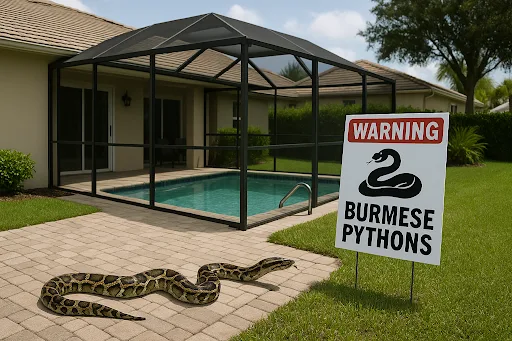Florida Pythons Boom: Shield Your Vacation Rental This Season
Florida’s Burmese python population isn’t just an Everglades curiosity anymore—it’s a hospitality headache. Hosts from Naples to Palm Beach are fielding anxious guest messages, HOA reminders, and higher insurance questionnaires about snakes on the property. One roach skittering across the kitchen tile can erase five-star ratings, spark refund demands, and land the listing in tomorrow’s headlines. The plan that follows—tempered by real-world site checks and after-hours rescue calls—keeps hosts ahead of the critters and the bookings rolling.
Why Are Pythons Booming in Florida?
Wildlife biologists now reckon some three hundred thousand Burmese pythons thread through South Florida’s sawgrass marshes—a startling climb from about thirty thousand ten years ago. An all-you-can-eat buffet of rabbits, raccoons, and baby gators, plus almost no natural enemies, fuels their population boom. Climate change plays a part too; warmer winters expand the reptiles’ northern range beyond Lake Okeechobee. Since travel restrictions lifted, vacation rentals have crept into South Florida suburbs once left to mangroves and Burmese pythons. Weekend tenants haul in coolers and haul out garbage bags laced with melon rinds—an open invite for hungry snakes.
Wildlife crews logged a record 1,949 python removals in 2024, the Florida Fish & Wildlife Conservation Commission reports. Early 2025 traps already run 12 percent ahead of that pace, proof the snake curve is still bending upward. Owners who rely on glowing reviews can’t wait for the state to solve the problem alone; proactive mitigation is now a business expense right next to pool service and landscaping.
First Line of Defense: Call a Pro
Python wrangling isn’t a DIY side hustle. Even juveniles pack serious muscle, and Florida statutes require permits for live removal or relocation. Insurance adjusters may deny wildlife-damage claims if you can’t prove you hired a licensed handler.
Paragraph 2 brings the action step. Contact a trusted local pest control service that’s certified in wildlife management. Because they already service the neighborhood, they know micro-migration patterns—how snakes follow lake edges, newly dug construction trenches, or canal bulkheads—and can install legal traps before a python graduates from “sighting” to “issue.”
Paragraph 3 underscores compliance. Certified techs photograph every capture, log GPS coordinates, and file paperwork with FWC’s Python Action Team. That record keeps you on the right side of county codes and lets guest-facing platforms know you’re acting responsibly.
NextGen Pest Solutions – Florida Pest-Control Business License #JB250184
DIY Precautions You Can Tackle This Weekend
A wrangler may be called when a python or black racer is spotted, yet long-term safety is secured along the property’s edges. Silver-dollar soffit gaps should be sealed, the crawl-space screen that clatters each time the dryer fires up is best replaced, and the philodendron creeping toward the window must be trimmed, not left to serve as a reptile on-ramp. In a University of Florida IFAS survey, yards kept neat—grass mowed, hedges clipped—were reported to see 43 percent fewer reptile visits than identical homes next door. Even a quick monthly leaf-blower sweep is recommended.
Five priority tasks:
- Any ground-level gap wider than a quarter-inch ought to be sealed—hardware cloth can be fitted over larger openings, while a shot of expanding foam fills the hairline cracks.
- Door sweeps that have gone missing should be replaced, and the garage door is best kept down whenever the family isn’t rolling through.
- Clear yard clutter—pool floats, lumber, children’s toys—where snakes shelter from midday heat.
- Mow grass below four inches and prune shrubs at least six inches off the ground to eliminate shaded “tubes.”
- Install motion-sensor lighting; sudden illumination often deters nocturnal predators.
Knocking out even two of these steps can drop your risk profile dramatically and may earn an insurance discount under the “preventive mitigation” rider some carriers offer.
Case Study: Naples Canal-Front Condo
Linda S., a Superhost with two units off Vanderbilt Lagoon, faced a nightmare when a four-foot juvenile python slithered onto her lanai while guests were grilling. The party bolted; the booking platform sided with the guests, and Linda refunded three nights—$1,200 gone. Afterward, she brought in a professional team that discovered gaps under the screens and a broken drain cover leading to the crawl space. They removed one additional snake, sealed entry points, and set quarterly inspections. Her listings recovered within a month, and subsequent reviews now applaud the “clear wildlife protocol” posted in the kitchen binder.
Takeaway: quick professional action plus transparent guest communication can turn a potential PR crisis into a trust-builder.
Educate Guests Without Spooking Them
Nobody flips through a welcome binder hoping for a horror story, yet leaving wildlife unmentioned invites panic later.
- A single “Wildlife Welcome” sheet does the trick: thumbnail photos of the usual suspects, a three-step plan—step back ten feet, ring the 24/7 host line, then call the FWC hotline—and guests stay informed without feeling spooked.
- Reminder to shut sliding doors swiftly—most indoor incursions start with a patio left ajar for “just a minute.”
- Note that feeding wildlife violates county code and harms animals.
Guests appreciate honesty; it turns potential fear into respect for local ecology.
Stay Current on Control Tactics
New tools appear every season. Big News Network recently covered robot “rabbits” used to lure pythons in the Everglades; the pilot captured 27 snakes in its first month, proving tech can scale what human hunters struggle to match. Keeping tabs on such innovations helps you adapt policies faster than competitors, earning higher placement in search results within crowded rental platforms.
Legal & Insurance Quick Hits
- Permits: Most Florida counties let a homeowner end a python encounter right there on the patio—no paperwork required. But the moment that snake is loaded into a truck bed and driven off, a wildlife permit needs to be in the glove box. Because county rules aren’t identical, their website should be the first click.
- Liability: Standard homeowner policies often exclude exotic-animal incidents. Ask your carrier about a wildlife endorsement.
- Guest disclosure: Platforms like Airbnb allow “inherent risk” declarations. A concise note about local wildlife can shield you in dispute mediation.
Homeowners may humanely kill Burmese pythons on private property without a permit; transporting a live or dead python off-site requires an FWC authorization.
FAQ
Q1: Are pythons dangerous to people?
They carry no venom, but a ten-foot Burmese can clamp down like bolt cutters and coil tight enough to finish off a beagle. Most injuries, though, come from the human side of the showdown—panicked guests trip over patio chairs or slam doors on their own fingers while bolting.
Q2: Do I need to list python activity in my rental description?
Florida law doesn’t require it, yet transparency reduces refund demands. A short disclosure about regional wildlife plus your response protocol usually suffices.
Q3: How often should I schedule professional inspections?
Most technicians pencil in a sweep every three months—timed to catch the reptiles’ usual breeding spurts. If the backyard backs onto a canal or brushes a wildlife preserve, shifting to a once-a-month walkthrough stacks the odds in the homeowner’s favor.
Q4: Can noise devices keep snakes away?
Neighborhood trials paint a clear picture: a sharp burst from a motion-sensing floodlight startles snakes far better, and stout mesh over crawl-space vents leaves them nowhere to squeeze through. Let the ultrasonic puck hum if you like, but rely on light and metal for real protection.
Conclusion: Turn the Python Problem Into a Five-Star Opportunity
Five-star ratings don’t depend on erasing Florida’s python boom; they depend on how calmly and quickly a vacation rental handles it. A snug perimeter—screens patched, vents wrapped in mesh, and sliding doors kept shut—pushes most snakes back to the mangroves. A standing relationship with a trusted local pest control service provides ready muscle for any stragglers. Slip a short “What to Do If You Spot a Python” card into the welcome binder and tweak it whenever state rules change. When wildlife protocols are treated with the same care as deep-cleaning and check-in, the property stays safe, and guests leave glowing reviews—even while Florida’s most infamous residents ride their population boom.






